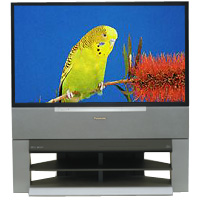 |


TechnoFILE is copyright and a registered trademark © ® of
Pandemonium Productions.
All rights reserved.
E-mail us Here!

Home Video Gets a Plasma Transfusion….New Technologies Compete with Rear Projectors by Jim Bray The old fashioned rear projection TV is facing serious competition. Not only is there brand new technology like the RCA LCOS (Liquid Crystal on Silicon) projector I previewed a while back, but liquid crystal and DLP projectors are getting really good (and comparatively affordable) and high tech plasma screens are finally bringing to life the old science fiction concept of wall mounted big screen TV's. Let's start with plasma, arguably the most exciting of the new technologies. In an indication that plasma is now starting to be taken seriously, these TV's are starting to crop up as background screens to the talking heads on TV broadcasts. This is a job that has traditionally been filled by rear projectors or chroma key insert effects so, if nothing else, this new "media feeding frenzy" should make plasma a familiar sight. The big downsides to plasma right now are price and black and white performance. As with other technological issues, however, these will undoubtedly be worked out - but right now they're definite considerations for consumers. Plasma prices are dropping, though a 42 inch screen will still set you back $10,000 or more. This puts them at a huge competitive disadvantage to rear projectors, which can be had for well under three grand these days. Then again, the average plasma screen is already HDTV-ready and most of them offer the soon-to-be-ubiquitous 16x9 aspect ratio. And of course they're comparatively light and small compared with the big rear projectors. Add to that the "Gee Whiz" factor that comes with these handsome units, which really do look like they stepped out of "2001: a Space Odyssey," and you can see why they're selling. Right now the typical plasma monitor comes in a 42 inch screen size, with a few 50 inchers also available. Depending on your room, 42 inches may not be big enough if you really like movies; I have a 57 inch widescreen rear projector and even though it dominates the room I find myself wishing for something bigger! Maybe it's just me and my delusions of grandeur…. Helping to decrease plasma TV prices is a recent move by Hitachi, Fujitsu and Sony to open a joint "mega plasma factory" in Miyazaki, Japan that will eventually be able to crank out some 70,000 plasma units a month. Models will range in size from 21 to 50 inches diagonally (and eventually, it's said, 60 inches!). The biggest plasma of which I've heard to date comes from Samsung, which has created (though it apparently isn't yet producing) a 63 inch model that should sell for somewhere around $30,000. Okay, these prices are ridiculous for most ordinary people, but within the next five years or so they should drop to $100 or less per inch, which would mean that a 42 inch screen will sell for $4200 or less. That could help bring plasma into the mainstream. While plasma's bound to get hot, new generations of front projection liquid crystal displays are also getting mighty attractive. Most are currently aimed at the business market, but some will work extremely well in the home theatre environment. Sony's VPLVW10HT, for example, is a 16x9, LCD front projector that retails for under $6000. It can throw an image onto screens from 40"-300" in size, measured diagonally, with a bright picture and, perhaps most important for DVD viewing today, Sony's "Digital Reality Creation" circuitry (DRC) that takes conventional NTSC pictures and ups them to near HDTV quality. DRC works very well and eliminates the scan lines that get so annoying as screen sizes get larger. The other type of projector that's poised to make a home theatre splash is DLP (digital light processing). Developed by Texas Instruments, DLP is available in front or rear projection units from manufacturers such as Zenith, Runco, Hitachi, Mitsubishi, and Panasonic. Panasonic's PT-52DL10 is a good representative of the species. It's an "ultra compact and lightweight" 52 inch 16x9 rear projection HDTV monitor that sells for $13,000 and offers all the home theatre TV features a consumer could want, combined with DLP's bright and high resolution picture. Naturally, all of these technologies will get more affordable - and better - over the coming years. This means you'll have an even broader range of choices to fit your life-style and your home theater. And that's never a bad thing. Jim Bray's technology columns are distributed by the TechnoFILE and Mochila Syndicates. Copyright Jim Bray.
|
|
|
| Support TechnoFile via Paypal |
| TechnoFILE's
E-letter We're pleased to offer our FREE private, subscription-based private E-mail service. It's the "no brainer" way to keep informed. Our Privacy Policy |